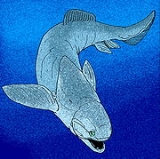
Titanichthys
Encyclopedia
Titanichthys agassizi was a giant, aberrant marine placoderm from the Late Devonian
. It approached Dunkleosteus
in size and build. Unlike its relative, however, T. agassizi had small, ineffective-looking mouth-plates that lacked a sharp cutting edge. It is presumed that the beast used its capacious mouth to swallow or inhale schools of small, anchovy
-like fish, or possibly krill
-like zooplankton
, and that the mouth-plates retained the prey while allowing the water to escape as it closed its mouth.
When the first specimens were found in Morocco by geologist Henri Termier
, Titanichthys was originally placed within the genus Gorgonichthys
- that is, after Termier was able to convince his colleagues that the bone scraps were of a placoderm, and not a dinosaur
. A junior synonym is Brontichthys, which should not be confused with another arthrodire, Bruntonichthys
of the Dinichthyidae.
Devonian
The Devonian is a geologic period and system of the Paleozoic Era spanning from the end of the Silurian Period, about 416.0 ± 2.8 Mya , to the beginning of the Carboniferous Period, about 359.2 ± 2.5 Mya...
. It approached Dunkleosteus
Dunkleosteus
Dunkleosteus is a genus of prehistoric fish, one of the largest arthrodire placoderms ever to have lived, existing during the Late Devonian period, about 380-360 million years ago.This hunter, measuring up to and weighing , was a hypercarnivorous apex predator...
in size and build. Unlike its relative, however, T. agassizi had small, ineffective-looking mouth-plates that lacked a sharp cutting edge. It is presumed that the beast used its capacious mouth to swallow or inhale schools of small, anchovy
Anchovy
Anchovies are a family of small, common salt-water forage fish. There are 144 species in 17 genera, found in the Atlantic, Indian, and Pacific Oceans. Anchovies are usually classified as an oily fish.-Description:...
-like fish, or possibly krill
Krill
Krill is the common name given to the order Euphausiacea of shrimp-like marine crustaceans. Also known as euphausiids, these small invertebrates are found in all oceans of the world...
-like zooplankton
Zooplankton
Zooplankton are heterotrophic plankton. Plankton are organisms drifting in oceans, seas, and bodies of fresh water. The word "zooplankton" is derived from the Greek zoon , meaning "animal", and , meaning "wanderer" or "drifter"...
, and that the mouth-plates retained the prey while allowing the water to escape as it closed its mouth.
When the first specimens were found in Morocco by geologist Henri Termier
Henri Termier
Professor Henri-François-Émile Termier was a French geologist.Born at Lyon into a scholarly family, he served in the First World War as an artillery officer during which he earned a Croix de guerre...
, Titanichthys was originally placed within the genus Gorgonichthys
Gorgonichthys
Gorgonichthys is an extinct arthrodire placoderm genus of the order Dinichthyoidea....
- that is, after Termier was able to convince his colleagues that the bone scraps were of a placoderm, and not a dinosaur
Dinosaur
Dinosaurs are a diverse group of animals of the clade and superorder Dinosauria. They were the dominant terrestrial vertebrates for over 160 million years, from the late Triassic period until the end of the Cretaceous , when the Cretaceous–Paleogene extinction event led to the extinction of...
. A junior synonym is Brontichthys, which should not be confused with another arthrodire, Bruntonichthys
Bruntonichthys
Bruntonichthys is an arthrodire placoderm from the Gogo Reef Formation. It was a small fish, having proportionately huge eyes, and small jaws. Researchers suggest it may have preyed on small mollusks....
of the Dinichthyidae.

